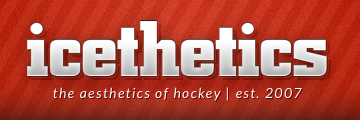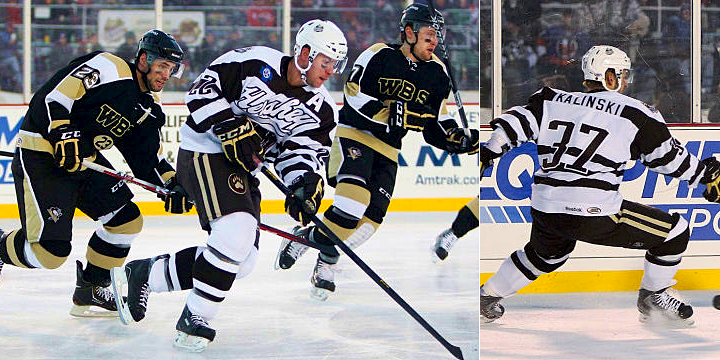Arena Logos: The AHL East
 Saturday · Feb 9 · 2013 | 11:05 AM PST
Saturday · Feb 9 · 2013 | 11:05 AM PST  6 Comments
6 Comments These posts on arena logos have been getting pretty decent feedback from you guys. So I figured I'd go ahead with a look at rinks from around the American Hockey League. We'll start with the Eastern Conference today and focus on the other half tomorrow.

We begin with the 34-year-old Glens Falls Civic Center, the temporary home of the Adirondack Phantoms — and former home of the Adirondack Red Wings for two decades. When the Spectrum was closed in 2009, the Philadelphia Phantoms were forced to find a new place to play. They headed up to Glens Falls, N.Y. but the plan was always to return to Pennsylvania. In time for the 2014-15 season, the team will depart Glens Falls for a new building in Allentown, Penn. where they'll be renamed the Lehigh Valley Phantoms.

The Times Union Center in Albany, N.Y. has hosted pro hockey since it opened in 1990 and is currently home to the Albany Devils. The fun started with the Albany Choppers of the IHL at a time when the building was named Knickerbocker Arena. But the IHL club was terrible and got run out of town after one season by a new nearby AHL team, the Capital District Islanders.
In 1993, the Islanders got a new owner who moved them into the Choppers' old building. They were renamed the Albany River Rats and endured two renamings of their building over the years — Pepsi Arena in 1997, and ultimately, Times Union Center in 2007. The River Rats moved to North Carolina and became the Charlotte Checkers in 2010. At the same time, the Lowell Devils left Massachusetts and ensured that Albany would continue to host AHL hockey.

The Broome County Veterans Memorial Arena doesn't have a terribly exciting name or logo, but that's par for the course when you're talking about 40-year-old buildings owned by municipalities. The Binghamton Senators haved played here since 2002 but they're far from the first. Hockey came to Broome County by way of the NAHL's Broome Dusters (clever) when the arena opened in 1973.
Four years later, they were replaced by the AHL when the Rhode Island Reds arrived in 1977 and became the Binghamton Dusters. The team was renamed Whalers in 1980 and Rangers in 1990. (Think you can probably track the NHL affiliation changes there.) In 1997 — after a 20-year run — the team left for Connecticut where they became the Hartford Wolf Pack.
During their five years without the AHL, Binghamton turned to the United Hockey League. Enter the B.C. Icemen (that's B.C. for Broome County, not British Columbia, of course). But they went away when the Prince Edward Island Senators franchise was re-established in Binghamton after a six-year hiatus.

Here's a modern-looking AHL arena logo. The Bridgeport Sound Tigers were the founding tenant of The Arena at Harbor Yard in 2001. Webster Bank bought the naming rights in 2011.

Remember the Binghamton Dusters from earlier? They're the Connecticut Whale now and host opponents at XL Center in Hartford, Conn. — a building that once housed NHL and WHA hockey. The Wolf Pack, as they were known then, arrived in 1997 to fill the void left by the Hartford Whalers, who moved to North Carolina.
The arena opened in 1975 as the home of the WHA's New England Whalers but the roof collapsed in 1978 and closed for a couple of years. By the time the building reopened, it was for NHL hockey. The naming rights were purchased in 2007 by XL Group, a financial services company. But that contract runs out later this year.

The Giant Center houses one of the AHL's oldest franchises, the Hershey Bears. It opened in 2002 in Hershey, Penn. and never looked back. Prior the move, the Bears played at Hersheypark Arena which is approaching its 80th birthday. But the team still uses that rink to practice.

Manchester, N.H. is where you'll find Verizon Wireless Arena and its sole tenant, the Manchester Monarchs. The team was founded in 2001 just in time to open the new building.

This one is a little tricky. The Norfolk Admirals technically play at Scope Arena in Norfolk, Va. — a building that opened in 1971. But the arena is part of a larger complex of venues, now known as Seven Venues — which uses the above logo. And I haven't been able to track down a current version of the Scope logo, if one even exists. Could definitely use a hand if there are any locals that can help out. The Ads have played at Scope since their inception in 1989.

The Cumberland County Civic Center is located in Portland, Maine. It opened in 1977 and has housed AHL hockey for all but one year since. In 1993, the CCCC welcomed the Portland Pirates to town from Baltimore, Md. but before that, the original tenant was the Maine Mariners. They departed for Rhode Island in 1992 where they currently exist as the Providence Bruins.

Hey, speaking of the Providence Bruins! The Bruins call the Dunkin' Donuts Center home, but only since their arrival in 1992. The building has a much longer history. It was simply the Providence Civic Center when it opened in 1972 as the second home of the Providence Reds (who would later become the Connecticut Whale, see above). That team left for Binghamton in 1977, which left a 15-year gap without pro hockey in Rhode Island's capital city.

The newest member of the AHL arena party is the Mile One Centre in St. John's, Newfoundland — but it's not their first rodeo. After a three-year absence, it returned to the hockey fray in 2011 with the arrival of the Manitoba Moose, who were booted from their home by the new Winnipeg Jets. Once in Newfoundland, they became the St. John's IceCaps.
The Mile One Centre opened in 2001 as the new home of the St. John's Maple Leafs, who arrived from Newmarket, Ont. in 1991. They went back to that province in 2005 and became the Toronto Marlies. From there, the arena was home to the QMJHL's St. John's Fog Devils, who left in 2008 for Montreal and eventually became the Blainville-Boisbriand Armada in 2011.

Opened in 1972, the Springfield Civic Center has always been a place for hockey. And like Hartford's XL Center, it has the distinction of hosting NHL action for a time. Remember how XL's roof collapsed in 1978? Springfield, Mass. is where the Whalers played during renovations — and made their transition from WHA to NHL.
The Springfield Kings became the first resident of this arena in 1972 after leaving the aging Eastern States Coliseum, or The Big E. They were originally the Indians when founded in 1926 and switched back to that moniker in 1974. But two decades later, the team was sold and moved to Worcester, Mass. where they became the IceCats. Today, that team is the Peoria Rivermen.
In 1994, the AHL expanded to fill the gap left by the Indians' departure. Enter the Springfield Falcons we now know. And in 2005, the Massachusetts Mutual Life Insurance Company bought the naming rights to the building, today called MassMutual Center.

All right. Worst. Arena logo. Ever. Certainly the most corporate one I've ever seen. Syracuse, N.Y.'s War Memorial Arena is part of a group of venues collectively known as The Oncenter. Each has an indistinctive logo like this with varying icons on the left. Not impressed. But the Syracuse Crunch call it home.
The building itself has a long history, having opened way back in 1951. It may actually be the oldest AHL building still in use today. It's housed five different hockey teams over the years, but the Crunch arrived in 1994 after 14 years without the sport. Prior to that, the franchise played two seasons in Ontario as the Hamilton Canucks.

The Mohegan Sun Arena at Casey Plaza (in Wilkes-Barre, Penn.) opened in 1999 and re-established a dormant AHL franchise that had been affiliated with the Quebec Nordiques for 15 years. Last known as the Cornwall Aces in 1996, the Wilkes-Barre/Scranton Penguins began play when the building was called the Northeastern Pennsylvania Civic Arena and Convention Center.
A year after it opened, the naming rights were purchased by First Union. (Oh no, bank flashbacks!) And as we learned a couple weeks ago, First Union became Wachovia in 2003. The contract on Wachovia Arena at Casey Plaza ended in 2010 when Mohegan Sun at Pocono Downs took up the flag.

We finish today with the home of the Worcester Sharks — and yet another building named for a financial institution, the DCU Center. Digital Federal Credit Union paid for naming rights in 2004, two years before the Cleveland Barons relocated to Massachusetts. The building opened in 1982 as the Centrum in Worcester (and later the awful Worcester's Centrum Centre in 1997) but it hasn't always had hockey. The AHL was housed from 1994 to 2005 after the Springfield Indians moved and became the Worcester IceCats.
That's all for today. We'll get to the west tomorrow. (Ha, see what I did there?)
























